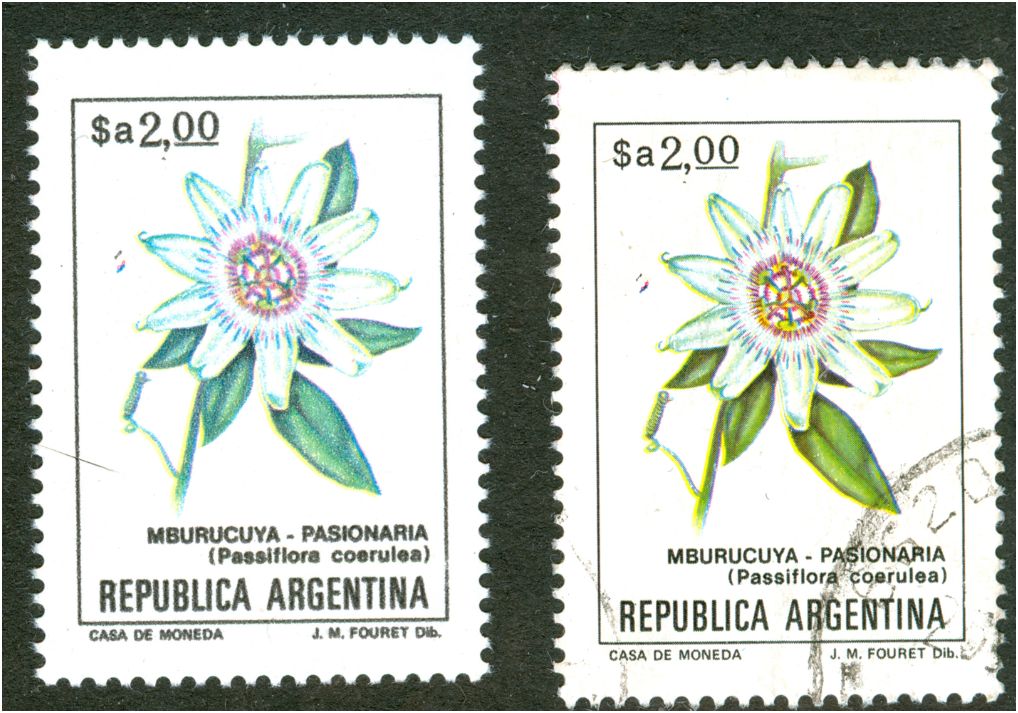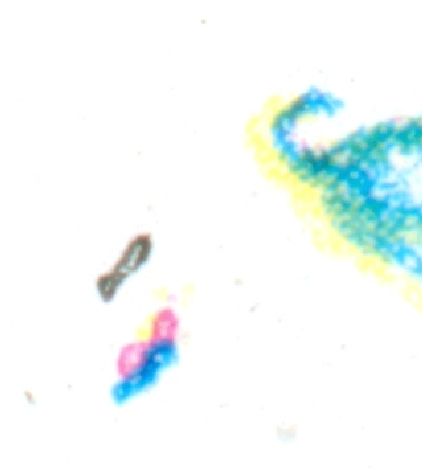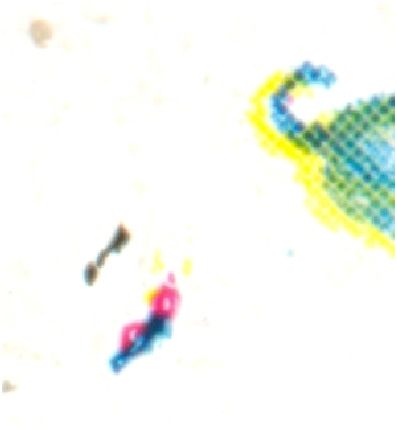| nummer / number | waarde / denomination | beschrijving / description | kleur / colour | afbeelding / illustration | ||
| Rasterdiepdruk - photogravure - huecograbado Casa de Moneda de la Nación, B.A. | ||||||
| 1982-01 | 200 Chinita de Campo (Zinnia peruviana) | rasterdiepdruk / photogravure / huecograbado | CMYK |  |
||
| b | xx.xx.1982 | gecoat papier - fosforescentie in de coating / coated paper - phosphorescence in the coating / papel tizado con fosforescencia en capa | ||||
| 1982-02 | 300 Campanilla (Ipomola purpurea *) | rasterdiepdruk / photogravure / huecograbado | CMYK |  |
||
| b | xx.xx.1982 | gecoat papier - fosforescentie in de coating / coated paper - phosphorescence in the coating / papel tizado con fosforescencia en capa | ||||
| * | verkeerde Latijnse naam! / wrong latin name / nombre incorrecto latín | |||||
| 1982-03 | 400 Clavel del Aire (Tillandsia aeranthos) | rasterdiepdruk / photogravure / huecograbado | CMYK |  |
||
| b | xx.xx.1982 | gecoat papier - fosforescentie in de coating / coated paper - phosphorescence in the coating / papel tizado con fosforescencia en capa | ||||
| 1982-04 | 500 Palo borracho (Chorisia speciosa) | rasterdiepdruk / photogravure / huecograbado | CMYK |  |
||
| a | xx.xx.1982 | gecoat papier - witmakers in de coating / coated paper - OBA in the coating / papel tizado con blanqueadores en capa! | ||||
| b | xx.xx.1982 | gecoat papier - fosforescentie in de coating / coated paper - phosphorescence in the coating / papel tizado con fosforescencia en capa | ||||
| 1982-05 | 800 Flor de patito (Oncidium bifolium) | rasterdiepdruk / photogravure / huecograbado | CMYK |  |
||
| b | xx.xx.1982 | gecoat papier - fosforescentie in de coating / coated paper - phosphorescence in the coating / papel tizado con fosforescencia en capa | ||||
| 1982-06 | 1000 Ceibo (Erythrina crista-galli) | rasterdiepdruk / photogravure / huecograbado | CMYK |  |
||
| b | xx.xx.1982 | gecoat papier - fosforescentie in de coating / coated paper - phosphorescence in the coating / papel tizado con fosforescencia en capa | ||||
| 1982-07 | 2000 Jacaranda - Tarco (Jacaranda mimosifolia) | rasterdiepdruk / photogravure / huecograbado | CMYK |  |
||
| b | xx.xx.1982 | gecoat papier - fosforescentie in de coating / coated paper - phosphorescence in the coating / papel tizado con fosforescencia en capa | ||||
| 1982-08 | 3000 Pata da vaca (Bauhinia candicans) | rasterdiepdruk / photogravure / huecograbado | CMYK |  |
||
| a | xx.xx.1982 | gecoat papier - witmakers in de coating / coated paper - OBA in the coating / papel tizado con blanqueadores en capa! | ||||
| b | xx.xx.1982 | gecoat papier - fosforescentie in de coating / coated paper - phosphorescence in the coating / papel tizado con fosforescencia en capa | ||||
| 1982-09 | 5000 Guaran amarillo Guaranguay (Tecoma stans) | rasterdiepdruk / photogravure / huecograbado | CMYK |  |
||
| a | xx.xx.1982 | gecoat papier - witmakers in de coating / coated paper - OBA in the coating / papel tizado con blanqueadores en capa! | ||||
| b | xx.xx.1982 | gecoat papier - fosforescentie in de coating / coated paper - phosphorescence in the coating / papel tizado con fosforescencia en capa | ||||
| 1982-10 | 10000 Lapacho negro (Tabebuia ipe) | rasterdiepdruk / photogravure / huecograbado | CMYK |  |
||
| a | xx.xx.1982 | gecoat papier - witmakers in de coating / coated paper - OBA in the coating / papel tizado con blanqueadores en capa! | ||||
| 1982-11 | 20000 Mburucuya - Pasionaria (Passiflora coerulea) | rasterdiepdruk / photogravure / huecograbado | CMYK |  |
||
| a | xx.xx.1982 | gecoat papier - witmakers in de coating / coated paper - OBA in the coating / papel tizado con blanqueadores en capa! | ||||
| 1982-12 | 30000 Patito (Aristolochia littoralis) | rasterdiepdruk / photogravure / huecograbado | CMYK |  |
||
| a | xx.xx.1982 | gecoat papier - witmakers in de coating / coated paper - OBA in the coating / papel tizado con blanqueadores en capa! | ||||
| 1982-13 | 50000 Flor malvinense (Oxalis enneaphylla) | rasterdiepdruk / photogravure /huecograbado | CMYK |  |
||
| a | xx.xx.1982 | gecoat papier - witmakers in de coating / coated paper - OBA in the coating / papel tizado con blanqueadores en capa! | ||||
| 1982-14 | 5000 Guaran amarillo Guaranguay (Tecoma stans) + 50 year SOFITU(cuman) 07.08.1982 | rasterdiepdruk / photogravure / huecograbado | CMYK |  |
||
| b | xx.xx.1982 | gecoat papier - fosforescentie in de coating / coated paper - phosphorescence in the coating / papel tizado con fosforescencia en capa | ||||
Have a look at:
The individual trees:
Pata da VacaJacarandaLapacho negroGuaranguayPalo borrachoCeibo


